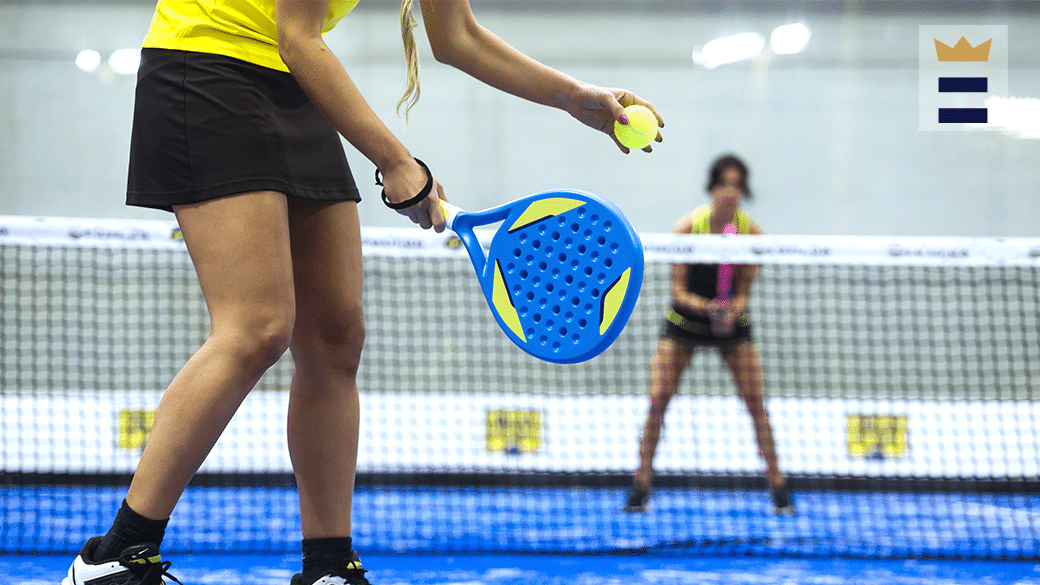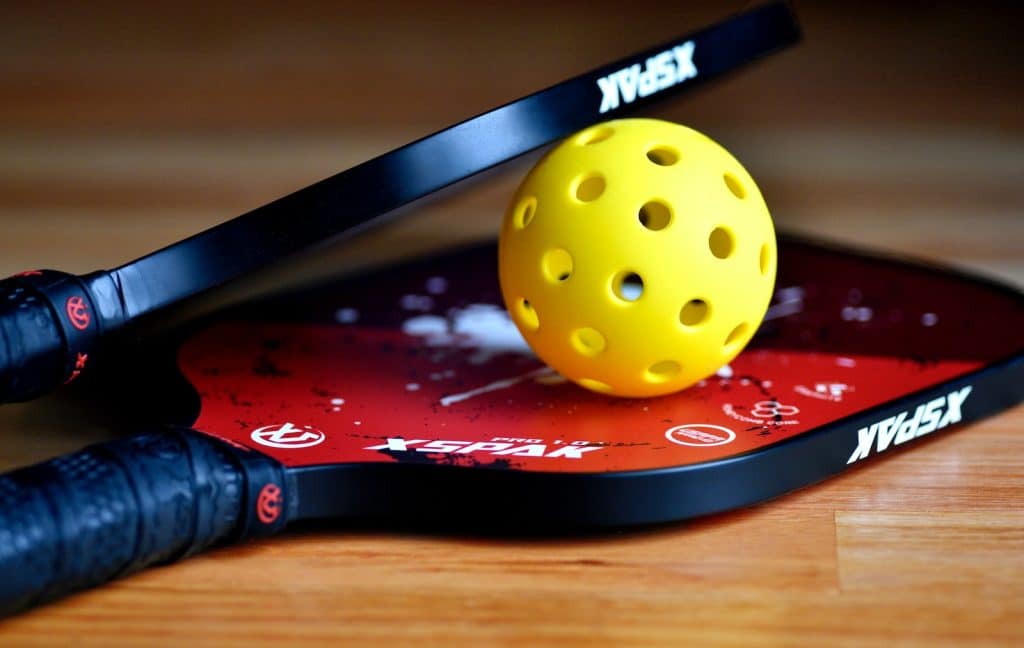Pickleball has exploded in popularity over the last decade, becoming one of the fastest growing sports. With its friendly gameplay and ease of learning, it has a unique appeal. But pickleball is not the only paddle sport that is fun and engaging. The closely related game of paddleball shares similarities but also key differences.
Pickleball is often confused with similar racket sports. Many people ask if it is the same as paddleball, padel, or paddle tennis. These are all valid questions that I couldn’t find after Googling for a bit, so I’ve decided to put together a definitive paddleball vs pickleball guide.
Table of Contents
- 1 What is Pickleball?
- 2 What is Paddleball?
- 3 Court Access Tensions
- 4 Comparing the Sports
- 5 How Other Paddle Sports Compare
- 6 Pickleball or Paddleball: Which Courts You?
- 7 FAQs
- 7.1 Is there a difference between pickleball and paddle ball?
- 7.2 Is padel the same as pickle?
- 7.3 What is the difference between padel and paddle?
- 7.4 Which sport is bigger, padel or pickleball?
- 7.5 Which is better, paddleball or pickleball?
- 7.6 How do paddleball, pickleball, and tennis compare?
- 7.7 Which is better for beginners, paddleball or pickleball?
- 7.8 What are the sizes of paddle tennis and pickleball courts?
- 7.9 How popular are pickleball and padel compared to each other?
What is Pickleball?
Pickleball was invented in 1965 by Joel Pritchard and Bill Bell on Bainbridge Island, Washington. After coming home from golf and finding their families bored, they attempted to set up an improvised version of badminton using ping pong paddles and a perforated plastic ball, leading to the genesis of pickleball.
Over 50+ years pickleball’s popularity gradually grew in the Pacific Northwest and broader U.S. Referred to as “the fastest growing sport”, there are now millions of recreational players of all ages enjoying the game at dedicated courts. With its friendly competition and accessibility adding to the appeal, many new players are discovering it each year. Pickleball gained popularity among a select group of individuals in the Pacific Northwest, with one of its early enthusiasts being a young Bill Gates.
As far as rules and gameplay, pickleball is played on a 20′ x 44′ court with a tennis-style net set at 34 inches high at midpoint. Matches are usually doubles focused, with underhand serves initiating play. Players score points only when serving, leading to quick volley exchanges up to the low net. The signature “kitchen” area adds a unique element, prohibiting volleys from that zone.
Common pickleball equipment includes solid or perforated paddles often made from polymer materials, as well as plastic balls with holes similarly to Whiffle balls. These key elements combined give pickleball its accessible, pared down paddle sport essence, perfect for new players and recreational enjoyment.
What is Paddleball?
Paddleball is an old racquet sport, older than pickleball. Some think it began with handball. Handball was a big deal in American cities before World War I. Dr. Frank Peer Beal from Brooklyn, NY loved handball, but it hurt his hands hitting the hard ball repeatedly. To fix this, he made a paddle stick to hit the ball and shared it with friends, starting paddleball. Paddleball developed in the early 1900s as an offshoot of tennis, using solid wooden paddles to volley against various backboard and wall surfaces.
A different kind of paddleball, called four-wall paddleball, was made by Earl Riskey, a gym teacher, in 1930 at the University of Michigan in Ann Arbor, Michigan.
One-wall paddleball, as the name suggests, utilizes a single wall with sidelines and a short front wall. Four-wall courts are completely enclosed, requiring adaptive play rebounding shots off all surfaces. Over the 20th century, standardized rules formed, including defined service boxes and scoring systems up to 21 points.
Common paddleball strategy focuses on controlling ball pace and placement, outmaneuvering opponents. Matches feature long, rapid rallies versus pickleball’s brief exchanges. As a very fast-paced and reflex-dependent game, paddleball demands greater athleticism and skill development for competent play.
Paddleball equipment showcases design advances, improving power and control. Graphite paddle composites borrowed from racquetball and tennis replaced basic wooden paddles. Regular bouncing balls are favored over perforated. Distinct court infrastructure and offerings, however, vary regionally in the U.S. limiting newcomer exposure.
Court Access Tensions
The COVID-19 pandemic sparked a surge in outdoor activities, propelling two paddle sports, pickleball and padel, into the limelight. Both offered socially distanced fun under the sun, but their paths to popularity have diverged dramatically, leading to a surprising conflict.
Pickleball, with its smaller court and gentler gameplay, proved to be a perfect fit for pandemic restrictions. Existing tennis courts could be transformed into pickleball courts with just some taped lines, making it inexpensive and easy to expand. This adaptability fueled its popularity, turning Manu Martin, a padel coach, into an Instagram influencer with over 300k followers.
Padel, on the other hand, required dedicated, purpose-built courts costing upwards of $30,000. This steeper entry point hindered its immediate accessibility, although its fast-paced, action-packed gameplay continues to attract enthusiasts.
However, pickleball’s rapid encroachment on tennis courts sparked outrage among some established players. Tennis legend Martina Navratilova voiced her disapproval, demanding that pickleball “build its own courts.” In extreme cases, resentment simmered over, leading to acts of vandalism against converted tennis courts.
The tension manifested in the form of “Club Leftist Tennis,” a group that penned an “Against Pickleball” manifesto. They portrayed pickleball as an “astroturfed, venture capital-backed parasite on public space,” highlighting the growing animosity between the two communities.
While pickleball holds the advantage of affordability and rapid growth, the conflict showcases the complexities of sharing public space. Finding ways for both sports to coexist harmoniously, perhaps through dedicated facilities or flexible scheduling, will be crucial to ensuring everyone can enjoy their preferred paddle sport under the sun.
Will pickleball’s momentum triumph over established tennis traditions? Or can a truce be brokered in this battle for court supremacy? Only time will tell how this fascinating rivalry unfolds.
Comparing the Sports
| Feature | Paddleball | Pickleball |
|---|---|---|
| Court Size | 12′ x 25′ rectangle with four walls | 20′ x 44′ rectangle with no walls |
| Ball | Depressurized rubber ball similar to a tennis ball | Perforated plastic ball |
| Serve | Overhand | Underhand |
| Net Height | 31 inches | 36 inches |
| Non-Volley Zone | No | Yes (7′ area on each side of the net where volleying is not allowed) |
| Pace | Faster exchanges and longer matches | Slower |
| Accessibility | Steep learning curve | Very easy to pick up |
| Difficulty | More challenging | Easier to learn |
| Wall Play | Yes, integral to gameplay | No |
| Equipment | Solid wooden paddles | Solid composite paddles |
| Popularity | Less popular but growing | More popular, especially in the United States |
Similarities
Pickleball and paddleball share foundational DNA as paddle sports. Both utilize solid paddle racquets, bouncing balls, defined court spaces and some form of net/front wall setup to facilitate competitive back and forth play.
Serving, baseline play and volley exchanges sending the ball to the opponent’s side before it bounces form essential gameplay components. Scoring logic follows tennis conventions, as do court positioning, boundaries and etiquette. Having some paddle familiarity helps pickup both sports more easily.
In addition to mechanical similarities enabling transferrable skills, they promote holistic fitness improvement with cardiovascular demands from active movement and rallies along with muscle workouts. The social community team aspects spawn further enjoyment and engagement for many players initially drawn to try rec-league play.
Differences
While sharing plenty in common, subtle equipment design and significant court and scoring variances differentiate paddleball and pickleball. These disparities culminate in reasonably distinct game flow, strategies, and appeal.
Paddleball’s enclosed walls versus pickleball’s single central net greatly affects pace, ball placement importance and shot dynamics. The constant threat of errant bounces amid four-wall courts inspires more conservative, low-risk returns to sustain rallies. Pickleball’s signature kitchen no-volley area also has no paddleball equivalent, impacting scoring tactics.
Equipment factors into the experiential contrasts too. Standard bouncy balls enable faster exchanges compared with pickleball’s whiffle-style spheres. Paddleball paddles focus preserving ball control given narrow court confines; pickleball paddles allow adding spin, pace diversity. Slim paddleball margins magnify equipment familiarity benefits.
Accessibility constitutes the starkest divergence. Pickleball explicitly engineered ease of adoption enables broad participant skill levels. Paddleball by comparison, remains more niche struggling mainstream expansion due to facility scarcity and steep learning curve even amid a participatory zeal core base. These dynamics propagate awareness and growth differences.
How Other Paddle Sports Compare
Paddleball and pickleball aren’t the only games fought with paddles. Related sports like tennis, racquetball, and squash share some crossover, as do upstarts padel and paddle tennis catching attention. Each carved certain niches, but pickleball’s rare combination of accessibility and excitement makes it uniquely poised for continuing ascent.
Paddle tennis, for instance, fields comparable equipment on bigger courts and adds complex rules, diminishing newcomer viability. Padel fuses elements of tennis and squash but stays confined regionally, hampering ubiquity. Pickleball’s founders deliberately integrated ideal aspects from various racquet pastimes to craft both ease of play and sustained engagement, explaining its unprecedented near viral adoption pattern.
Pickleball or Paddleball: Which Courts You?
In summary, pickleball and paddleball offer differentiated paddle sport experiences. Paddleball prioritizes athleticism, rapid flow and strategic prowess within confined competitive cauldrons. Pickleball emphasizes friendly amusement more than mastery, with groundstrokes not as essential thanks to its signature kitchen. Lingering commonalities enable some skill transferability, but court environs and scoring pacing remain distinct enough to caution direct comparisons.
Interested players are encouraged to experience both sports firsthand. Pickleball offers a welcoming conduit to paddle familiarity. Its soaring popularity means ample opportunities for beginners and moderate players will remain for years. But don’t dismiss paddleball either! Once proficient, its feverish adrenaline surges create a one-of-a-kind allure for that subset bold enough to plunge into its gladiatorial-like fires. Ultimately, pickleball and paddleball each brilliantly fulfill standalone niche roles despite frequent associations.



